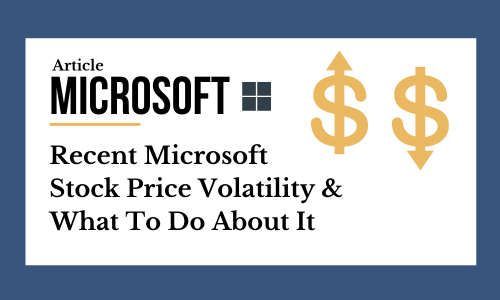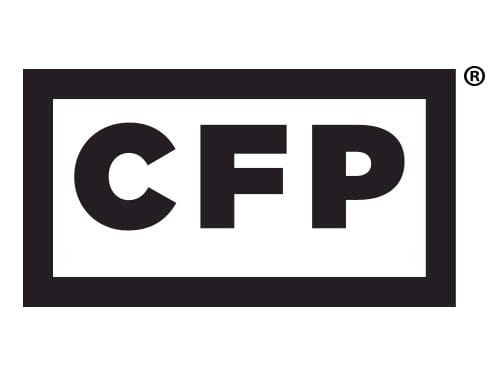Recent Microsoft Stock Price Volatility and What You Should Do About It

As we all know, stock market volatility is normal, and a part of the investment experience. What is important to be in tune with however, is that when dealing with one company rather than a more diversified basket of stocks, the volatility can be much more extreme and lasting1. In recent months, Microsoft stock has experienced significant volatility. This article explores the reasons behind this fluctuation and provides strategies for managing your holdings.
A current volatility example is stock market darling Nvidia, which saw a significant increase in their stock price ahead of the much-anticipated stock split earlier this year. Interest in the stock reached fever pitch this summer, though unfortunately many of those who joined the party and purchased the stock after the split have had a much different experience. From the less than two-month period of the June 20th high to the early August low, the stock had dropped an astonishing 30%, meaning someone who had purchased $1 million of Nvidia would have seen their balance drop to $700,000 in a matter of months.
While this is a small sample size and Nvidia can very well come back to new heights (as they’ve done many times before), this is not always the case. For example, rival chip maker Intel still sits at less than a third of its year 2000 highs nearly 25 years later! Someone who held $1 million in Intel stock in January 2000 would still only have about $300,000 today.
What Does This Mean for Microsoft Stock?
Now let’s turn our attention to the company that we all have a lot of interest in. After a fantastic rally over the last two years, we have seen Microsoft’s stock price come back to earth and drop more than 10% from its June all-time highs through the end of August. These volatile periods serve as a good reminder that even good companies can go through some tough patches. While we do expect Microsoft’s stock to recover and reach new heights, it is unknown how long this recovery will take (in Intel’s case we’re still waiting).
Wall Street expectations for Microsoft are sky high and can serve to be their own worst enemy. Very good company results might not be viewed as good enough and still result in the stock going down. At a $3 trillion company valuation, for the stock price to double, that means the value of Microsoft would have to grow to $6 trillion, or over 20% of the United States’ full-year GDP!
The good news is Microsoft is still up significantly this year, providing a great opportunity to review your Microsoft exposure and make sure you are positioned to best serve your financial goals.
Three Strategies to Manage Your Microsoft Stock
Beyond your Microsoft stock holdings, as an employee of Microsoft you have additional skin in the game through unvested stock awards as well as Microsoft signing your pay checks. A good rule of thumb is not to have more than 10% of your portfolio in the stock of one company, and this especially rings true given this added exposure. Here are some strategies to manage your Microsoft stock exposure
- Diversify your stock exposure without a big tax hit: Many people we talk to feel stuck in their Microsoft stock given the big tax gains. This recent volatility provides an opportunity to sell your recent stock vests at minimal gain, and in certain cases, a stock loss. This is the low-hanging fruit. For those that are hesitant to sell these shares at what may feel like a low, we would rather view it as an opportunity to reinvest into other investment holdings to add more diversification to your portfolio. Remember, it is not just what Microsoft stock does, rather what it does relative to other investment options – for example, the S&P 500 has doubled the performance of Microsoft stock so far this year2.
- Use your Microsoft stock to fund your retirement accounts and achieve tax savings: As your vested Microsoft stock is held in a brokerage account, it poses a unique opportunity to sell some of that stock and fund your tax advantaged retirement accounts. This can lead to substantial net tax savings and additional benefits by loading up your 401(k), HSA, backdoor Roth, and even your ESPP3. This can serve as a win-win to help you diversify your portfolio while also reducing your tax bill.
- Treat your future stock vests as a cash bonus: Vested RSUs are like receiving a cash bonus. Selling your shares at the time of vest doesn’t bear additional tax implications versus holding them. By keeping your RSUs invested in Microsoft stock it is the equivalent of taking a cash bonus and choosing to buy Microsoft stock with all of it. We instead advocate selling your stock when it vests and funding the advantaged investment vehicles available to you providing the added benefit of investment diversification.
Conclusion
In conclusion, by reviewing your Microsoft stock holdings and considering your financial goals, you can make informed decisions on how to best manage your exposure and potentially benefit from future growth. Given the large number of risks out there (election uncertainty, geopolitical tensions, highly valued stock market), it is crucial to have a plan in place and stay focused on your long-term financial goals. Consulting with a Certified Financial Planner can provide personalized guidance tailored to your unique situation, helping you navigate market volatility and make strategic investment decisions.
1There is no guarantee that a diversified portfolio will enhance overall returns or outperform a non-diversified portfolio. Diversification does not protect against market risk.
2The S&P 500 is a stock market index tracking the stock performance of 500 of the largest companies listed on stock exchanges in the United States. Indexes are unmanaged and cannot be invested in directly.
3Traditional IRA account owners have considerations to make before performing a Roth IRA conversion. These primarily include income tax consequences on the converted amount in the year of conversion, withdrawal limitations from a Roth IRA, and income limitations for future contributions to a Roth IRA. In addition, if you are required to take a required minimum distribution (RMD) in the year you convert, you must do so before converting to a Roth IRA.
Schedule a free financial check-up with one of our Certified Financial Planners to review your investment plan and make sure you are on the right track! CNBC referenced for historical stock data
Contact Us:
team@stablerwm.com | (425) 646-6327
No strategy assures success or protects against loss. Stabler Wealth Management and LPL Financial are not affiliated or endorsed by Microsoft.
Traditional IRA account owners have considerations to make before performing a Roth IRA conversion. These primarily include income tax consequences on the converted amount in the year of conversion, withdrawal limitations from a Roth IRA, and income limitations for future contributions to a Roth IRA. In addition, if you are required to take a required minimum distribution (RMD) in the year you convert, you must do so before converting to a Roth IRA.
Contributions to a traditional IRA may be tax deductible in the contribution year, with current income tax due at withdrawal. Withdrawals prior to age 59 ½ may result in a 10% IRS penalty tax in addition to current income tax.
Securities and financial planning services provided through LPL Financial, a Registered Investment Advisor. Member FINRA/SIPC.
Category
Stay Informed
Join our mailing list to receive monthly newsletters with information that impacts your financial decisions.

Certified Financial Planner
In Business 35+ Years